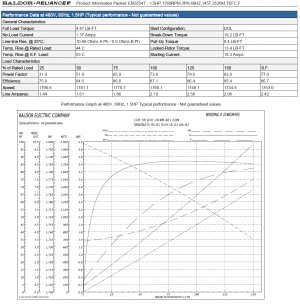-
Welcome back Guest! Did you know you can mentor other members here at H-M? If not, please check out our Relaunch of Hobby Machinist Mentoring Program!
You are using an out of date browser. It may not display this or other websites correctly.
You should upgrade or use an alternative browser.
You should upgrade or use an alternative browser.
3ph Motor Install, Need Recommendations
- Thread starter chevydyl
- Start date
- Joined
- Jun 15, 2013
- Messages
- 1,199
I like the idea of only 1 pulley set, with 2 steps for high and low, stick the motor shaft out the side of the cabinet where the original motor driven pulley is on the jackshaft
Here's the manual for my actual motor, except on the plate of my motor after looking at it again it's 1740 rpm
Here's the manual for my actual motor, except on the plate of my motor after looking at it again it's 1740 rpm
Attachments
- Joined
- Dec 8, 2013
- Messages
- 2,651
Each of those curves goes with a different one of the vertical scales on the left. Look at the key at the top to tell which goes with which.I like the idea of only 1 pulley set, with 2 steps for high and low, stick the motor shaft out the side of the cabinet where the original motor driven pulley is on the jackshaft
Here's the manual for my actual motor, except on the plate of my motor after looking at it again it's 1740 rpm
- Joined
- Dec 25, 2011
- Messages
- 10,552
OK. Based upon what mksj wrote, you can do what I suggested above, that is, use new pulleys the same size as the larger step on the existing 2-step ones. The rated top speed of all Atlas 10" and 12" since the early 1940's has been given as 2072 with a nominal 1740 RPM motor. So running the 3-phase motor off of 58 cps with the spindle belt in position 4 should yield that. At 90 cps, you would have around 3100 RPM. Unless you plan to do a lot of wood turning on very small diameters, that should be much faster than you would ever want to run. And of course, slowing the motor down and using the 4 steps on the cone pulley would get you down to the slowest speed. Plus there are still the back gears.
- Joined
- Dec 8, 2013
- Messages
- 2,651
The RPM curve starts at just under 1800 RPM at 0% of rated load and slopes down to the right, reaching 1735RPM at 150% of rated load. The bottom curve is torque, which goes to zero at zero load (as it has to).right, that's how I made the conclusion that is makes 0% of rated output at 1700rpm
Last edited:

